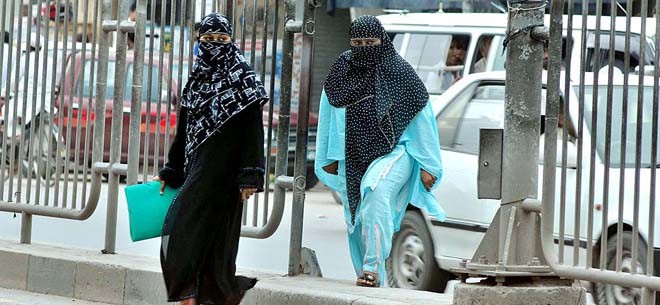
Security barriers and road-widening schemes are encroaching upon the space meant for pedestrians

After the attack on Karachi Airport Terminal and firing on the national airlines plane in Peshawar, it is reminded to us that we are in a state of war. Security threats, precautions and ring fencing of vital installations become inevitable.
But one finds that the most ordinary people are always impacted the most -- this time expansion of security barriers means the complete takeover of footpaths. Thus the pedestrians are forced to walk on the streets, jeopardising their safety and also the rationale of vehicle movement. Woes of pedestrians are manifolds and continue to escalate without any choice coming their way!
Our large cities have become very unfriendly locations for common people who wish to walk. Sighting frightened school children holding hands of their parents in a chance bid to cross the busy Shahrah-e-Faisal in Karachi every morning is a petrifying experience. Toddlers and small children hurtle across the fleeting vehicles to reach the schools across the street.
Thanks to the ill-conceived concept of ‘signal free corridors’, the mean velocities of cars and other vehicles have increased tremendously. With no speed limit regimes worth the name, the drivers enjoy field days by accelerating vehicles well beyond safety limits. And the ultimate brunt is borne by the hapless pedestrians. Two women and a child died instantly some time ago when two super vehicles knocked them down at a crossing in Defence Housing Authority in Karachi. The women were waiting on the sidewalk for their bus when the carefree boys lost control on their cars.
If one looks at the rising number of cars on our urban corridors, it will be very difficult to believe that Pakistan is a poor, indebted and terror-struck country. The swarming vehicles exert enormous pressure on the available right of way to facilitate their movement. At times, this pressure succeeds in annexing the shared alignment normally kept for other modes of transport as well as reducing the space for pedestrian movement.
In more congested areas, the road-widening schemes are undertaken as a routine solution to create more room for car movement. In many cases, the adjustments also block possibilities of pedestrian’s road crossings by creating physical barriers and unsurpassable curb grills.
Most of the cities and towns in our country are located in very warm weather zones. For pedestrians to walk long distances to avail any overhead crossing -- where ever it exists -- is highly unlikely! Needless to say that roads and streets have become non-negotiable due to the so called road improvements in many ways.
Whereas the walking space has vanished, the construction of barriers completely disrupts the movement of common people along thoroughfares. Residents and passersby along Saidpur Road in Rawalpindi/Islamabad face enormous problems due to encroachments that block pedestrian movement. The vehicle speeds in the same zone remain alarmingly high leading to accidents.
There is nothing wrong in owning and using a car provided folks abide by traffic laws and regulations. In our case, the opposite actually happens. There are several reasons for this state of affairs. In large urban centres, the cars are driven by drivers from various hinterlands who do not comprehend traffic regulations and their implications. They learn to operate the vehicles in a rudimentary manner without learning the traffic rules and principles of road safety. Drivers of public transit vehicles also belong to the same tribe.
Lawless driving attitudes are routinely displayed by drivers of government vehicles, water tankers, oil tankers, police force and goods transport vehicles. Young boys and under-aged teenagers can be observed speeding along the streets on cars and motorcycles. Many pedestrians have been severely injured and in some cases even lost their lives under the unruly behaviour of such motorists and motorcyclists. The traffic police usually remains a silent spectator in these ongoing exigencies against the walking brigade!
During planning and execution of development projects, negligible input is intended to help the pedestrians. For instance, wherever vehicle conflicts are found, the civic agencies develop grade separated movement corridors. In contrast, no attention is given to the problems of pedestrians which are becoming compounded each passing day.
The absence of traffic management on interchanges to allow pedestrians to cross the roads; prevention of parking of vehicles on footpaths/side walks as a routine; parking and movement of motorcycles along footpaths; encroachments on roadsides and footpaths; excavations and road-widening without regard for pedestrians; absence of sunshades and protection from rains along bus stops/public places; hazardous installations including outdoor signage/publicity hoardings, electricity pylons and poles across footpaths and total lack of facilities for disabled pedestrians are few core issues that affect the safe survival of millions of folks on the streets.
Pedestrian bridges only serve a small cross section of users. They are totally unusable for elderly and small children. It is also deplorable to find that pedestrians are not even protected by the law.
The ‘hit and run’ type accidents have increased tremendously in our cities with the weakest of pedestrians as the usual victims. Many important streets in Karachi and other cities have surveillance cameras with meticulous documentation capacity. Little or no benefit is drawn from evidences collected from these devices in the prosecution of traffic related crimes or prevention.
Those who cannot afford cars and motorbikes are also human beings. While motorists and motorcyclists are arguably people with stable socio-economic status, pedestrians are the mixed cross section of the society, dominated by low income groups. A few steps have to be taken without delay. Creation of pedestrian walking spaces along all major corridors of movement is the foremost requirement. Designation of traffic cops and volunteers along pedestrian sensitive zones must be done on a regular basis. Traffic education programmes with a focus on safe driving and road usage must be initiated. And those who end up exterminating innocent people by negligence should be brought to justice.